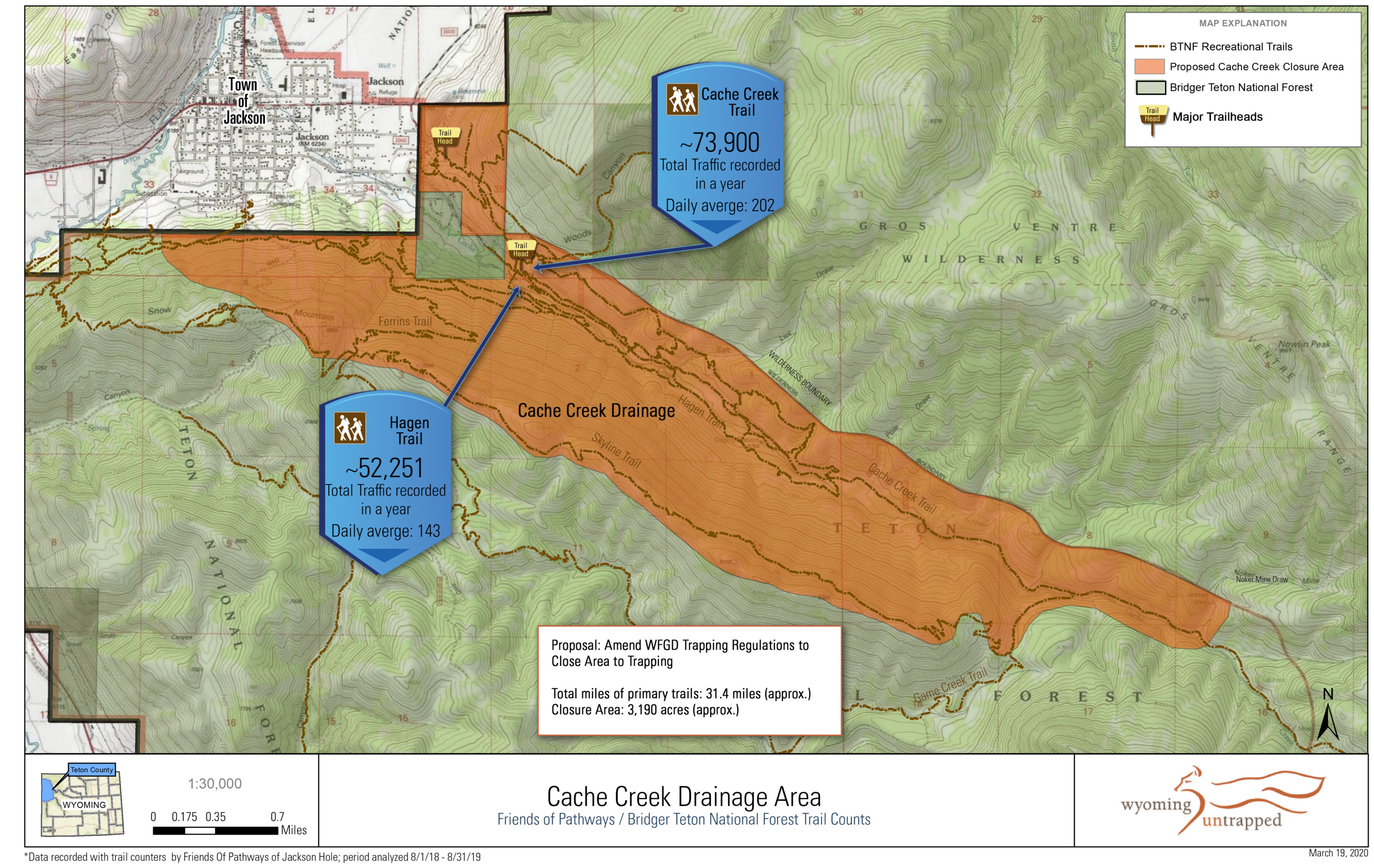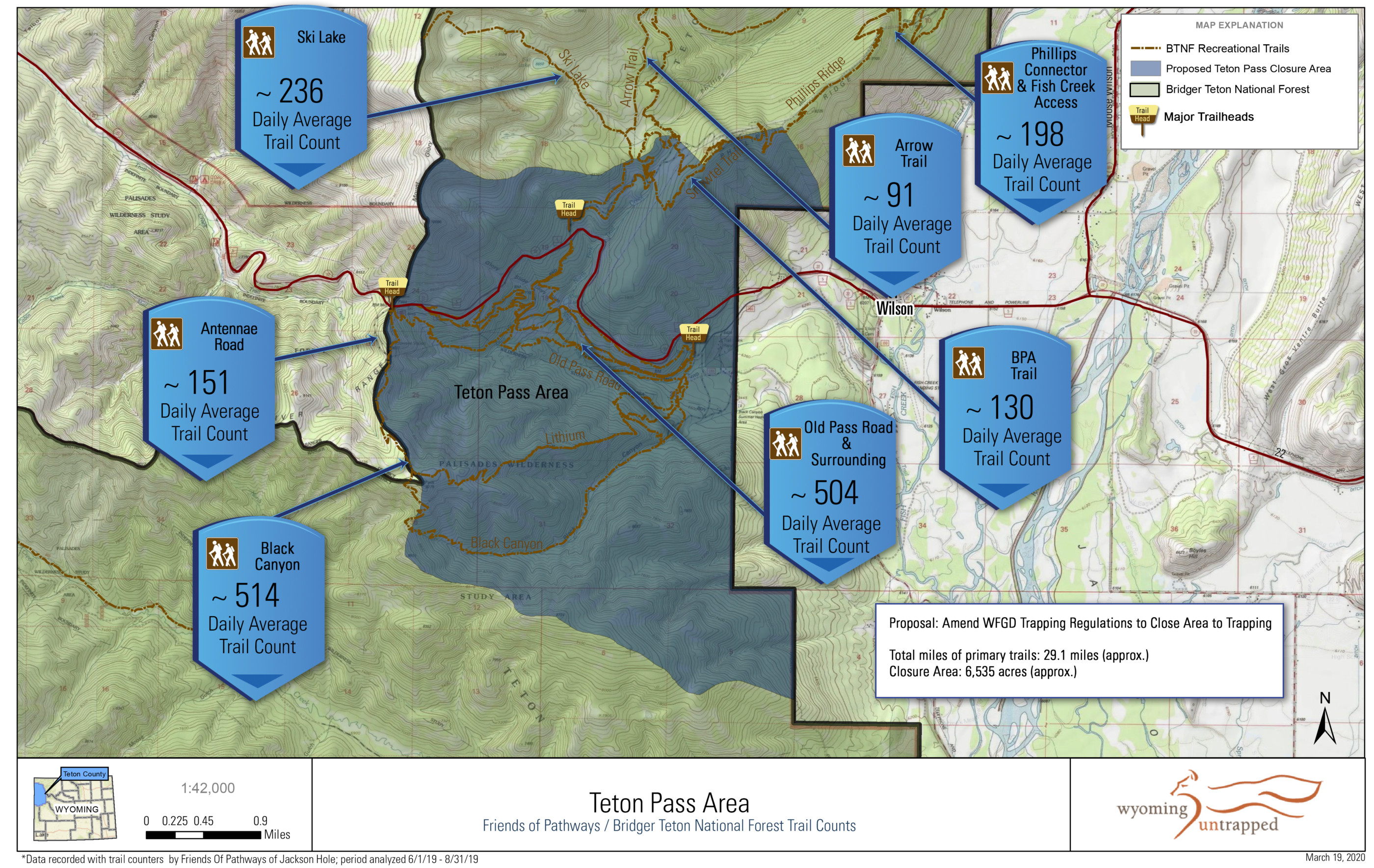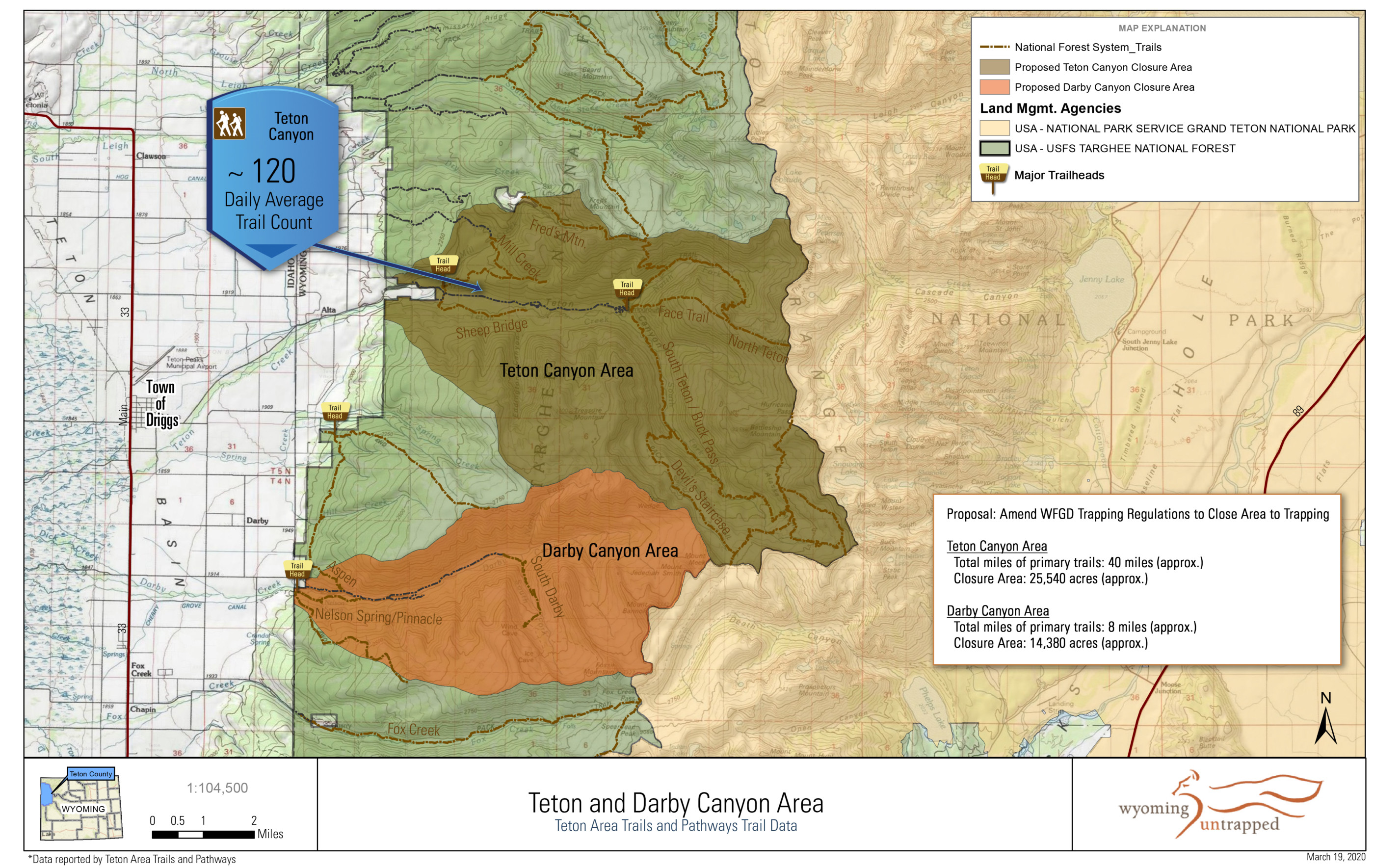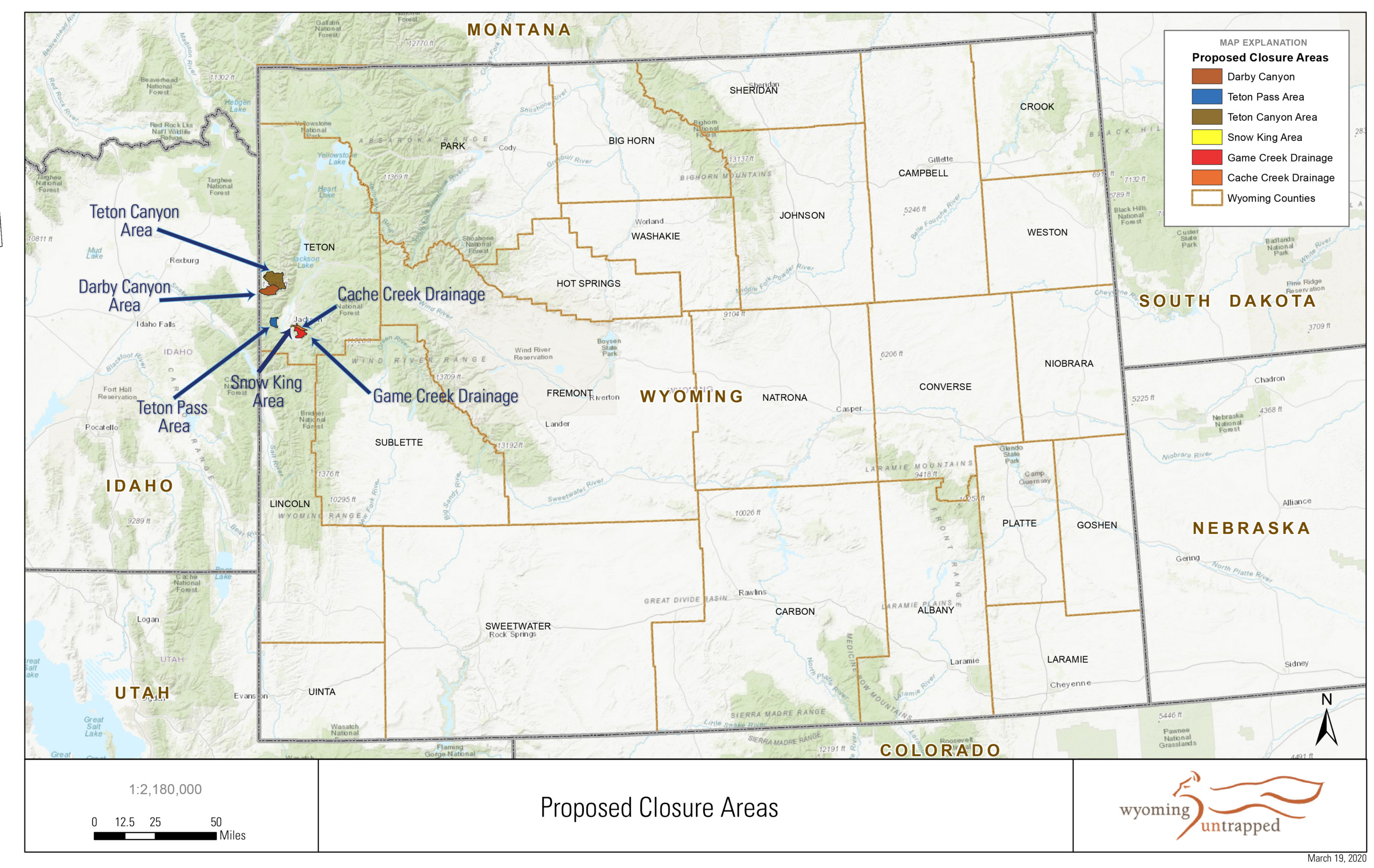
Trapping reform is a reality in 2020, Fourth step: WGFD Collaborative Public Meetings Trapping Reform - Sept 1,2,9,10 2020
Wyoming Untrapped petitioned the Wyoming Game and Fish Commission to consider trap-free reform in 2020 instead of the scheduled 2022. The Commission directed the Department to investigate by initiating an internal trapping reform stakeholder process statewide. Following several meetings and public surveys, this is where we are today. We are in this process now, on a fast-track. The public meetings are Sept 1,2,9,10. We hope you will consider attending the meetings, or joining virtually on Sept 9 in Laramie, and Sept 10 in Lander.
Friends, relatives and colleagues of Wyoming Untrapped: We need you! The time is now!
Trapping Reform in Action 2020
EXCITING NEWS! TRAPPING REFORM IS ON IN WYOMING!
Trapping reform requests by the public are being reviewed for collaboration starting this summer through November. The shift we have been seeking is here.
Following our January 2020 WU petitions, and partnership with the new organization, WY Trap Free-mont County (more good news), and with support of the Wyoming Coalition of Animal Protection, the WGF Commission directed WGFD to initiate an internal stakeholder trapping reform committee to reach out to the statewide public. Those results presented to the Commission last week resulted in a fast-track forward process for possible WGFD recommendations as well as Legislative draft bills and more. These may seem like small steps, but actually giant steps in our state.
Your letters, phone calls, conversations, and comments were heard. We will keep you tuned in during this process, and will reach out for additional action from the public.
Three of our trapping reform requests would be under WGFD jurisdiction, and the remainder require Legislative statute. The Legislature is aware of the WGFD process and possible draft bill recommendations.
Trap-free areas in Teton County, Fremont County (WY Trap FREEmont County), and statewide will be our first priority.
THANKS AGAIN, EVERYONE!
WU is breaking new ground! We are asking for the Wyoming public to attend a virtual meeting. Comments will only be accepted in person at a meeting, or virtually at the last two meetings Sept 9 in Laramie, and Sept 10 in Lander. We have listed take action talking points below. Thank you!
MEETING DATES:
| Date | Location |
| Sept 1 | Rock Springs, White Mountain Library – 2935 Sweetwater Dr. |
| Sept 2 | Jackson, Wort Hotel, Jackson Room – 50 Glenwood St. |
| Sept 3 | Sheridan, Best Western Sheridan Center – 612 N. Main St. |
| Sept 9 | Laramie, WGFD Regional Office – 1212 S. Adams St. Pre-register here: WGFD.WYO.gov/meetings |
| Sept 10 | Lander, The Inn at Lander, Wind River Rm – 260 Grandview Dr. Pre-register here: WGFD.WYO.gov/meetings |
Wildlife agencies need to act progressively on trapping reform 2020.
The incidental trapping of pets resulting in injuries and death continues to increase on our public lands. In the wake of these tragedies, current WGFD regulations leave recreationalist believing that there is no or little accountability in the sport of trapping and that there is “no safe place for recreationalist in Wyoming.” This dynamic is bad for the sport of trapping and bad for Wyoming.
TAKE ACTION September 1,2,9,10, 2020
VIRTUAL registration directions are attached to the meeting agendas for September 9 in Laramie, and September 10 in Lander.
*****NOTE******
Public comments will only be accepted at the public meetings in person, or during the virtual meetings on Sept 9,10.
CONTACT EMAIL:
Jason Hunter: Lander Region wildlife supervisor and lead of the internal working group
Jason.Hunter@wyo.gov
307-335-2609
REACH OUT TO YOUR COMMISSIONER:
peter.dube@wyo.gov (President)
patrick.crank@wyo.gov
mike.schmid@wyo.gov
david.rael@wyo.gov
gaylynn.byrd@wyo.gov
ralph.brokaw@wyo.gov
richard.ladwig@wyo.gov
WYOMING UNTRAPPED REQUESTED Trapping Reform LIST
Furbearer trapping regulations in the coming year will be adjusted and updated by the Wyoming Game and Fish Commission. WU has in the past, and continues to, assert that the following trapping regulation changes are necessary. Please stay tuned as we work through the process to create a safe and humane environment on our public lands.
- Trap Free Areas (Legislature and/or Commission) – Ask for trap-free areas for heavily used public recreation areas in Teton County, Fremont County and statewide. Access to trap free lands is a public right.
- 24–Hour Trap Checks ( Legislature) – Support of 24-hour trap checks statewide by writing your state representatives. Changing this law will require action by the Wyoming State Legislature. Wyoming is one of fourteen states that have not addressed the need for 24-hour trap checks. Wyoming state law currently requires a 72-hour check for leg hold traps and up to 13 days for snares and quick kill traps. Long trap check cycles result in suffering, pain, dehydration, starvation and loss of litters when a female/mother is trapped. For family pets that have been trapped, a 24-hour trap check could mean the difference between life and death.
- Ban of all trigger-loaded Power snares and Senneker snares (Legislature and/or Commission)– Power Snares and Senneker snares are extremely lethal, non-target species including pets are killed almost instantly. These traps should not be allowed on Wyoming’s landscape.
- Mandatory Signage (Legislature) – Caution signs, warning recreationalist, hunters, anglers and non-consumptive users of the dangers of trapping and specific trap placement on public lands, should be a mandatory requirement.
- Trap Set Backs (Commission) – Trap setbacks of 300 feet off of busy public trails statewide. The public has a right to safe travel on trails, this right extends to their traveling companions, including dogs and livestock.
- Mandatory Reporting – Non Target and Pets (Legislature) – Reporting of all non-target species trapped and/or killed, including pets. Trappers and the Wyoming Game and Fish would argue that trapping is a management tool. Without mandatory reporting there is no data, without data there is no management.
- Mandatory Reporting – All Species (Legislature) – Reporting of all species trapped. See above. Trappers and the Wyoming Game and Fish would argue that trapping is a management tool. Without mandatory reporting there is no data, without data there is no management.
- Mandatory Trapper Education (Legislature) – Mandatory trapper education should be a requirement. Idaho’s mandatory Trapper Education Law went into effect July 1, 2018. This law requires first time trappers to complete a Trapper Education Course before purchasing a license. The class is designed to teach trappers how to “minimize impact on others” as well as best practices to avoid trapping, injuring and killing non-target animals. Wyoming is lagging behind our neighboring states on trap reform that would make our public lands safer for all.
- Mandatory Conservation Stamp Purchase (Legislature) – “Funds from the conservation stamp purchase are used to support habitat and wildlife projects in Wyoming”. (Quote from WG&F website) Anglers and Hunters are required to purchase a Conservation Stamp, trappers are not. Trappers, who use the public’s wildlife for economic gain, should, more than any other user, be required to purchase a Conservation Stamp.
- Live Traps (Commission) – Live traps should be used wherever and whenever possible. Live traps would ensure that non target species, including protected and endangered species, can be released unharmed. Snares, leg hold, Conibear, Senneker and Power Snares are non-discriminate, they kill and maim regardless of species and protection status.
- Require all traps and snares to be removed at the end of trapping season (Legislature) – Thousands of traps and snares are left behind on our public landscapes at the end of trapping season. Some remain active. Trappers should be responsible for cleaning up all litter and hazards which they have placed on the land.
- Initiate statewide trapping reform stakeholder task force ( Legislature) – Trapping reform awareness statewide is growing rapidly which is initiating more public involvement and demand for immediate change.
- Review furbearer trapping regulations every two years ( Legislature) – Trapping regulations are scheduled for review on a three-year time frame. However, hunting and fishing are reviewed every two years.
WYOMING GAME AND FISH LIST OF POTENTIAL REVISIONS TO TRAPPING STATUTES and COMMISSION REGULATIONS:
We attempted to contact nearly 300 stakeholders around the state representing (in alphabetical order): Animal Shelters, County Predator Management Boards, Dog Owners (bird hunters and those who had trapping conflicts), Landowners, Legislators, NGOs, Other State or Local Governmental Agencies, Outfitters, General Public, Federal Public Land Agencies, Sportspersons, Trappers, Public Land User Groups, Veterinarians and Wildlife Services. We were able to have conversations with nearly 140 individuals/groups during a 14 day period and left messages and/or emails to an additional 60+ individuals (summary attached). Please stay tuned as we work through the process to create a safe and humane environment on our public lands.
As a result of these conversations, we identified a number of potential revisions to the trapping statutes and Commission regulations as well as opportunities to improve communication with stakeholders, including the following:
- Support for mandatory trapper education, concerns about trapping practices and trapper ethics
- Support for education/training about trapping for recreationalists and dog owners (concerns about safety and dogs off-leash or not under control)
- Support for trapping setbacks
- Support for signage (not on individual traps) about trapping potentially occurring in areas
- Concerns for non-target captures and support for reporting all non-target catches
- Concerns and discussions about snare check period
- Concerns about the lack of information collected related to furbearer harvest and lack of harvest quotas
- Support for mandatory Conservation Stamp requirements for trappers
- Support for trap type restrictions and/or trap free areas
In response to the common themes that arose during personal contacts with stakeholders, we developed the following list of topics to present and further develop during a series of stakeholder meetings in the fall of 2020:
-
- The Department will develop recommendations for the Wyoming State Legislature requiring mandatory trapper education.
a. The current Association of Fish and Wildlife Agencies approved online course may be sufficient until a Wyoming specific course could be developed or in person classes could be offered. - Develop consistent trapping education topics/themes relevant to those using public lands (hiking, walking dogs, bird watching, riding bikes, trail running, etc.)
a. Develop a page on the Department’s website containing all trapping specific information
b. Develop informational signs for use on Commission owned lands (WHMAs/WMAs) containing basic trapping information and a link (QR code) for more information in those areas with cell reception.
c. Work with public land management agencies to promote similar signage at trailheads/recreation areas.
d. Work with partners and stakeholder groups to provide hand tools at major trailheads or parking areas (similar to loaner lifejacket program) that can be used to remove a pet from a trap or snare. Sell tools through the Department’s Alternative Enterprises/website/Regional Offices.
e. Host/Co-host/promote how to release your pet workshops and other non-trapper based trapping education training around the state.
f. Update/redesign the trapping brochure to provide more information (species ID, education opportunities, messages, etc.) - Further develop recommended trap setback requirements and definitions. The Department will provide those recommendations to the Wyoming State Legislature to regulate trap setbacks for predatory animals and furbearers.
a. Public trails: Recommend 30’ setback
i. Public trails: defined as any trail on public land designated by administrative signs or numbers or as designated on the most current official map of the agency.
b. Public campgrounds, trailheads and recreation sites: Recommend 300’ setback
i. Campground: defined as any campground on public land designated by an administrative agency.
ii. Trailhead: defined as any trailhead on public land designated by an administrative agency.
iii. Recreation site: defined as any site with construction improvements made for recreation as designated by an administrative agency including, but not limited to, picnic areas, boat launches, fishing access areas, etc. - Develop a database and app to track voluntary reporting of non-target species trapped (including dogs). The Department will provide those recommendations to the Wyoming State Legislature to require reporting of all non-target species trapped.
- The Department will provide recommendations to the Wyoming State Legislature to reduce the check period requirement for snares (may need to add exemption to regulation for predator control work, but language is already included in the statute).
- Form a Department Furbearer Working Group to keep up to date with furbearer management practices, population trends and evaluate the need for harvest quotas, season date/species closure modifications, etc.
- The Department will provide recommendations to the Wyoming State Legislature to require Conservation Stamps for trappers and anyone using Commission owned or administered properties (antler hunters, dog walkers, bird watchers, other recreators, etc.).
- Look into trap and snare restrictions (RAM power snare, spring-loaded snares, etc.) and Commission owned or administered land closures during heavy use periods (pheasant release areas, etc.).
- The Department will develop recommendations for the Wyoming State Legislature requiring mandatory trapper education.
Talking Points
Original words directly from your own heart and mind are more likely to be given consideration than words and phrases that sound scripted. See the take-action box above to email your comments to Jason Hunter, Lander Region wildlife supervisor and lead of the internal working group: jason.hunter@wyo.gov. If you prefer a personal connection with your Commissioner, feel free to call or email directly. Thank you!
WHY TRAPPING REFORM IS URGENT IN 2020
- The incidental trapping of pets resulting in injuries and death continues to increase on our public lands.
In the wake of these tragedies, current WGFD regulations leave recreationalist believing that there is no or little accountability in the sport of trapping and that there is “no safe place for recreationalist in Wyoming.” This dynamic is bad for the sport of trapping and bad for Wyoming. - Over the last several years, WU has recorded 71+ reported dog trapping incidents in Wyoming.
Ten of these died. Seven of the 71+ incidents were in Teton County. There could be many more out there, but no official record exists. Just recently, two trapping incidents took place in a week. Just a couple days before the Christmas 2019 holiday, a dangerous trapline was set in the Cache Creek area adjacent to town. In this case, the trapper was cited for two violations and appeared in the Teton County court. A few days later, on January 4, 2020, a beloved pet, “Mac,” was caught in a lethal power snare and died within two minutes in the arms of Karen Zoller on public land in Fremont County. When WU asked for action on Mac’s case, some of the WGFD staff had never heard of these new snares, increasing the danger on our public lands. Emotions are high, and Wyoming residents are now reaching out to you and their electeds. - To avoid future incidents, we propose the establishment of criteria to guide trapping closures on “highly used public recreation areas” statewide,
Beginning with areas that have documented conflict histories, such as Teton County, Fremont County, Park County, and the towns Laramie, Pinedale and Rock Springs. Examples of “a highly used public area” in Teton County are Cache Creek, Game Creek, Old Pass Road, Snow King Trail Network, Teton Canyon and Darby Canyon. Today, the overall use of the Cache Creek trail system continues to rise and is estimated as high as 1526 daily, with an annual average of 400 people per day per a trail counter data summary 2019. GIS maps of these areas shows the trail count numbers, and the need for trapping closures. Overall Map. - The pure cruelty of trapping causing injuries, exposure, dehydration and mental stress, and often immense suffering.
All trap-check time requirements should be reduced to 24 hour trap checks, or should traps be eliminated from our landscapes. Jeremy Bentham famously asked, “The question is not, ‘Can they reason?’ Nor, ‘Can they talk?’ But, “can they suffer?'” - WU is asking for the ban of all trigger-loaded snares like the one that recently killed “Mac” in Fremont County. Our request compares any mechanical advantage assisted snare to the dangerous large size body grip traps, 330 conibears. The same non-selectivity and the same lethality. Dogs, cats, nontarget raptors and game animals and livestock will be more seriously injured or killed by these snares. The trappers can argue that the time until death of their target adult prime coyotes or bobcats will be reduced – – – but their ability to release young, or non target animals ( including domestic dogs) will be gone. And your ability to release you own dog while hiking or hunting before it suffocates will be reduced. These mechanically advantaged snares should be prohibited.
- On behalf of Wyoming Untrapped, Mac, and the citizens of Wyoming,
please consider restricting the use of all power snares, such as the Senneker spring snare or quick-kill snares, as soon as possible. - WGF Commission and WGF Department are our wildlife management leaders.
The failure to respond to the increase of land-use conflicts across Wyoming, specifically in Teton and Fremont Counties, perpetuates land use conflict. At the Lander WGFD workshop participants were reminded to be responsible land users and that their pets’ welfare is the sole responsibility of their owners. Blaming grieving residents for failure to see and avoid hidden lethal traps on public lands is ridiculous. We know Wyoming can do better and ask you to please step up and lead. - Given the danger present today by power snares hidden and loaded on public land,
we request that the topic of power snare restriction be considered immediately on all public and private land in the state. Given WGFC procedures and protocol, please add this topic to our request for trapping regulation amendment this year, instead of waiting until 2022. - Unacceptable deaths and severe injuries to non-target species; even animals released alive may later die from their injuries.
We don’t know how many non-target animals are trapped/snared, injured or killed in traps each year. All of the ~thousands of non-target animals should be required reporting by trappers. - Personal experience with a companion animal caught in a trap.
Warning signs should be required in areas where there are traps and snares to increase public safety. Traps are legal on all public trails where dogs can be walked. There should be 300 ft setbacks off trails, or trap-free areas where anyone can have a reasonable expectation of safety on our public lands. Trappers should be accountable for injuries or death to your pet. - Please consider the following trapping reform:
trap-free areas for heavily used public recreation areas statewide, required signage where traps and snares are present, reporting of all species trapped, a ban of the new deadly trigger-loaded power snare and Senneker snare, reporting of all non-target species trapped and/or killed, including pets, trap setbacks of 300 feet off of busy public trails statewide, required purchase of Conservation Stamp for all trappers, use of live traps whenever possible, mandatory trapper education, and support of 24-hour trap checks statewide. - Our public lands should remain safe havens for all.
All people, pets and wildlife should have a reasonable expectation for safety on our public lands, which means trap-free areas for all.
- There are emerging trends in national wildlife management.
We value and protect wildlife as vital contributors to the health of our public landscapes, and for the intrinsic character and worth of all furbearing animals. We value the significant impact of wildlife watching on tourism – Wyoming’s 2nd largest industry. Wyoming’s wildlife management is not keeping pace with our modern society’s views. - Wildlife management should better represent the values of all citizens.
Our wildlife is a public treasure owned equally by all citizens and taxpayers. Therefore, it is not just that a few people are allowed to indiscriminately trap and kill this wildlife. Trapping and snaring greatly reduces the number of animals and thus the number of wildlife sightings for the public – depriving them of much pleasure. - There is an absence of sportsmanship, fair chase, and compassion in trapping.
Every animal in Wyoming, including endangered species, is a possible victim of traps and snares. It is not fair chase to not know your target, or to sit at home on a couch and wait for a catch. - The overall management of trapping is rarely cost-effective.
A furbearer trapping license costs $45 for all you can catch. How can that be cost-effective for our state? Perhaps one license should be required for each furbearer species and a limited quota. - Trapping, which is not based on a science foundation, does little or nothing for effectively managing any species population.
We don’t have a population count on our state furbearers, but we allow unlimited quotas. We should place quotas on all furbearer trapping. Where is the science? - Trapping lost its charm long ago as a Wyoming tradition, let alone an American one.
A growing debate about the legitimacy of trapping shows that a shift is coming. Trapping for fun, trophies, fur and feeding one’s ego is no longer acceptable by a growing modern population. - Trapping rarely serves any citizen other than the one who owns the trap.
It is time to create a statewide Trapping Advisory Committee to lend a citizen’s perspective to WGFD in reviewing the science and management of trapping, and predicting and anticipating public sentiment.







